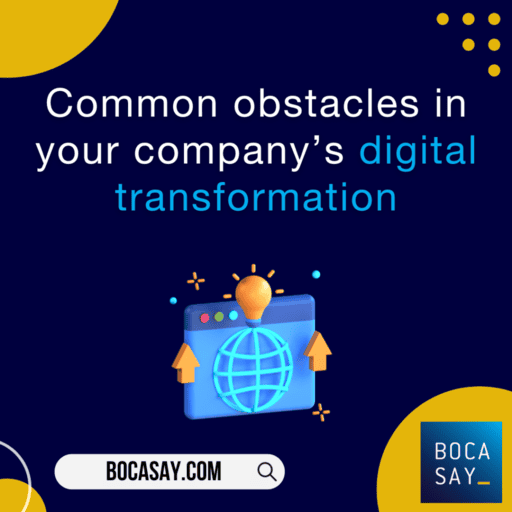Common Obstacles in your Company’s Digital Transformation
The digital transformation of a company essentially refers to the integration of digital technology into all departments and areas of the organization. This results in a fundamental change in the way a company operates and how it ultimately creates and delivers value.
Digital transformation encompasses a cultural shift that requires a company to adopt a brand-new way of thinking across the entire enterprise. Overall, the major challenge of digital transformation for companies is made up of several common obstacles.
In this article, our offshore outsourcing company, Bocasay, outlines a range of common obstacles that companies will have to face in order to succeed in their digital transformation.

Leadership 🚀
In order to embody best practices, great leaders need to be the first to immerse themselves in their company’s digital transformation. As the digital ecosystem rapidly develops, the leadership vision must be updated whenever possible. Any evolution must start from the top (leadership) in order to be effective.
Organizational Culture 🤝
People are central to any digital transformation and that’s why a change in mindset is necessary in order to succeed. It is crucial that everyone – from new employees to senior management – is exactly on the same page.
Digital culture is directly linked to internet culture. Younger generations often best represent the pillars of this new culture:
- Openness.
- Communication.
- Creativity.
- Horizontality.
Digital transformation is driven by an open-market business philosophy. Work with people from other departments, build on employees’ ideas, test things, learn from them and challenge them. A digital culture does not adhere to strict hierarchical patterns, and leads to new organizations that allow you to work more flexibly and faster.
The changing needs of customers 🤔
We live in an experience economy and more than ever, customers care about how they perceive your brand.
The global pandemic has changed the way consumers interact with brands. Customers expect better personalization, faster responses from companies, and they want active engagement across multiple channels. With rising expectations and rapidly evolving customer needs, today’s brands cannot succeed with one major digital overhaul.
Viewing digital transformation as a one-time project, rather than an ongoing process, is proving to be a major challenge for companies. They must not only embrace this radical change, but also quickly assess how to leverage all available digital opportunities in order to reach and satisfy all their customers.
𝕎𝕒𝕟𝕥 𝕥𝕠 𝕤𝕥𝕒𝕪 𝕔𝕠𝕞𝕡𝕖𝕥𝕚𝕥𝕚𝕧𝕖 𝕚𝕟 𝕪𝕠𝕦𝕣 𝕚𝕟𝕕𝕦𝕤𝕥𝕣𝕪 𝕓𝕪 𝕓𝕠𝕠𝕤𝕥𝕚𝕟𝕘 𝕪𝕠𝕦𝕣 𝕕𝕚𝕘𝕚𝕥𝕒𝕝 𝕥𝕣𝕒𝕟𝕤𝕗𝕠𝕣𝕞𝕒𝕥𝕚𝕠𝕟? 𝕐𝕠𝕦 𝕔𝕒𝕟 𝕔𝕠𝕦𝕟𝕥 𝕠𝕟 𝔹𝕠𝕔𝕒𝕤𝕒𝕪 𝕠𝕗𝕗𝕤𝕙𝕠𝕣𝕖 𝕠𝕦𝕥𝕤𝕠𝕦𝕣𝕔𝕚𝕟𝕘 𝕔𝕠𝕞𝕡𝕒𝕟𝕪. 𝕆𝕦𝕣 𝕥𝕒𝕝𝕖𝕟𝕥𝕖𝕕 𝕕𝕖𝕧𝕖𝕝𝕠𝕡𝕖𝕣𝕤 𝕒𝕣𝕖 𝕓𝕪 𝕪𝕠𝕦𝕣 𝕤𝕚𝕕𝕖 𝕗𝕠𝕣 𝕒𝕝𝕝 𝕪𝕠𝕦𝕣 𝕕𝕚𝕘𝕚𝕥𝕒𝕝 𝕔𝕙𝕒𝕝𝕝𝕖𝕟𝕘𝕖𝕤! ℂ𝕠𝕟𝕥𝕒𝕔𝕥 𝕦𝕤 𝕥𝕠 𝕘𝕖𝕥 𝕪𝕠𝕦𝕣 𝕗𝕣𝕖𝕖 𝕢𝕦𝕠𝕥𝕖!
The evolution of technology 🔝
Technology is constantly evolving. The way we listen to music, shop online and use social media, is completely different than it was only a few years ago. And this evolution is even more apparent in the professional sector.
Technological advances in areas such as robotics, artificial intelligence and machine learning have produced many labor-saving devices and processes. Automated teller machines, cash registers and online ordering, are just a few examples of what has been achieved through digital development in the last decade alone.
New technology can be daunting and certainly presents a significant challenge to organizations undergoing digital transformation. Both from an implementation and data integration perspective, as well as from the perspective of the end-user experience. Leaders need to consider all of the above during the early stages of any transformation project and look for the most intuitive and integrated IT systems.
The digitization of internal processes 💻
Another challenge of digital transformation involves the streamlining of a company’s internal processes and procedures. While the development of new digital products and services is focused externally – for clients – transforming company processes is primarily an internal challenge.
For many companies, this often means having to adopt internal processes that can operate seamlessly in an increasingly digitalized environment, and by sometimes replacing traditional tools with digital ones.
For example, artificial intelligence systems can be deployed in manufacturing companies to ensure that they always stay ahead of the supply chain. AI-based sales forecasts can help with inventory and financial planning, as well as inform buyers that they need to order certain components to fulfill future orders.
In short, process automation is about reducing turnaround time and operating more efficiently, which ultimately impacts the bottom line of any business.
However, keep in mind that you don’t have to simply digitize every single company process. More importantly, you need to identify the right areas and tools where digitization brings value not only to the business itself, but also to its customers.
Leaving old systems behind ♻️
Even within the world of IT, it is sometimes difficult to get out of your comfort zone. Some companies are still using outdated software and applications, despite the availability of more agile and robust platforms. After all, they have invested a lot of capital in these tools and they are still reaping the benefits.
However, by still using outdated software and technology, these companies represent one of the biggest drags of digital transformation. This is because they are often slow and inflexible, making it difficult to adapt to data and system migrations, as well as to integrate with any efficient new technologies. Not to mention the increased vulnerability to security breaches.

The skills gap 🏆
As companies introduce digitalization into their organizations, almost every job these days requires at least basic digital IT skills. Even non-technical job positions often require basic IT know-how.
Business inefficiency is increasingly exacerbated by a shortage of IT talent. Expertise in analytics, cloud, cybersecurity, enterprise architecture, digital experience and other areas is critical to any successful digital transformation.
Companies can find themselves struggling with digital transformation simply because of a lack of qualified personnel. One of the most cost-effective and rapid solutions is to collaborate with offshore outsourcing centers. More and more companies are partnering with offshore IT agencies because they provide almost immediate availability of highly skilled IT developers.
Budget constraints 💰
Many companies face funding issues during their digital transformation planning. Integrating new tools, training employees, hiring specialized digital skills and consultants will undoubtedly increase costs for companies.
Unfortunately, due to initial investments in outdated technology, senior management can often be skeptical about the viability of the entire process and are often not willing to immediately allocate the necessary budgets.